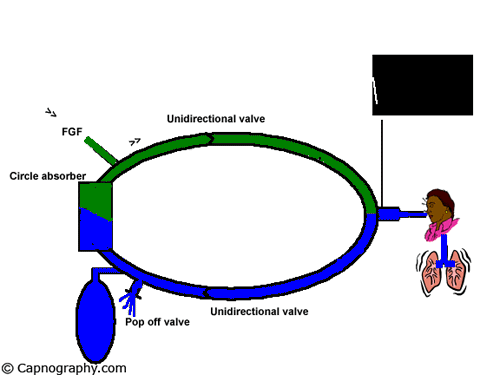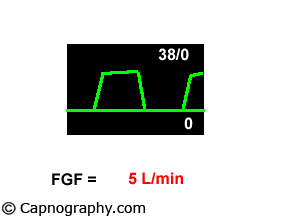Circle breathing system
M Ravi Shankar MD
Professor and Chair of Anesthesia,
JIPMER, Pondicherry, India
Brigham and Women’s Hospital, Harvard Medical Schoo
|
|
Functional analysis

Effect of FGF on capnogram

Rebreathing capnograms are due to
Exhausted soda lime
 |
 |


The essential components of the circle system are, (1) a sodalime canister, (2) Two unidirectional valves, (3) Fresh gas entry, (4) Y-piece to connect to the patient, (5) Reservoir bag (6) a relief valve and (7) low resistance interconnecting tubing. The arrangement of the components is shown in figure above. For efficient functioning of the system the following criteria should fulfilled. (1) There should be two unidirectional valves on either side of the reservoir bag, (2) Relief valve should be positioned in the expiratory limb only, (3) The FGF should enter the system proximal to the inspiratory unidirectional valve.
Functional analysis:
During inspiration the FG along with the co2 free gas in the reservoir bag flow through the inspiratory limb and inspiratory unidirectional valve to the patient. No flow takes place in the expiratory limb as the expiratory unidirectional valve is closed by back pressure transmitted to the valve. During expiration the inspiratory unidirectional valve closes and the expired gas flows through the expiratory unidirectional valve in the expiratory limb to the sodalime canister and to the reservoir bag. The co2 is absorbed in the canister. The FGF from the machine continues to fill the reservoir bag. When the reservoir is full the relief valve opens and the excess gas is vented to atmosphere. By selecting a suitable position for the relief valve, the expired gas can be selectively vented when the FGF is more than the alveolar ventilation. To facilitate controlled ventilation the relief valve has to be partly closed and the excess gas is vented during inspiration. The gas flow pattern is similar to that described above.
The advantages and disadvantages of the various arrangements of the components were analyzed by Eger and Ethans1. The relative positions of the components of the circle system are of particular importance to the functioning of the system only when the FGF is high, the gas components of the system unmixed and co2 absorber not used. When the FGF is reduced below the alveolar ventilation, the co2 absorber is a must as the gas in the system become more uniformly mixed, and the relative position of the system’s components become less important
Totally closed system:
The systems with co2 absorption can be used in a completely closed mode. After a period of approximately 10-20 minutes breathing with high inflow of fresh gas for denitrogenation, the expiratory valve is closed. The FGF is then adjusted to meet only the patients basal oxygen requirements together with anaesthetic. A number of advantages have been demonstrated for totally closed systems.
A) Economy: The FGF could be reduced to as low as 250 – 500 ml of oxygen. The consumption of Halothane/Isoflurane has been found to be around 3.5 ml/hour19.
b) Humidification: In the completely closed system, once the equilibrium has been established, the inspired gas will be fully saturated with water vapour20.
C) Reduction of heat loss: In addition to conserving water the totally closed system will also conserve heat. The co2 absorption is an exothermic reaction and the system may actively assist in maintaining body temperature.
D) Reduction in atmospheric pollution: Once the expiratory valve has been closed, no anaesthetic escapes, except for the small percutaneous loss from the patient.
E) Control of anaesthesia: It is possible to compute the time course of uptake of anaesthetic in a patient of known size and add the appropriate quantity of the anaesthetic to the circuit at a rate decreasing in a manner calculated to maintain a constant alveolar concentration21. In practice an alveolar concentration of about 1.3 x MAC is found to be suitable.
The technique has several potential disadvantages.
i) A greater knowledge of uptake and distribution is required to master closed circuit anaesthesia.
ii) Inability to alter any concentration quickly.
iii) Real danger of hypercapnia may result from, a) an inactive absorber, B) incompetent unidirectional valves and c) incorrect use of absorber bypass.
1. Eager EI., Ethans, C.T.: The effects of inflow, overflow and valve placement on economy of circle system. Anesthesiology, 1968, 29, 93-100.
2. Baum JA, Aitkenhead AR. Low flow anaesthesia. Anaesthesia 1995; 50(supplement):37-44.
3. Kleemann, P.P. Humidity of anaesthetic gases with respect to low flow anaesthesia. Anaesthesia and Intensive Care, 1994, 22 (4), 396-408.

 Twitter
Twitter Youtube
Youtube










